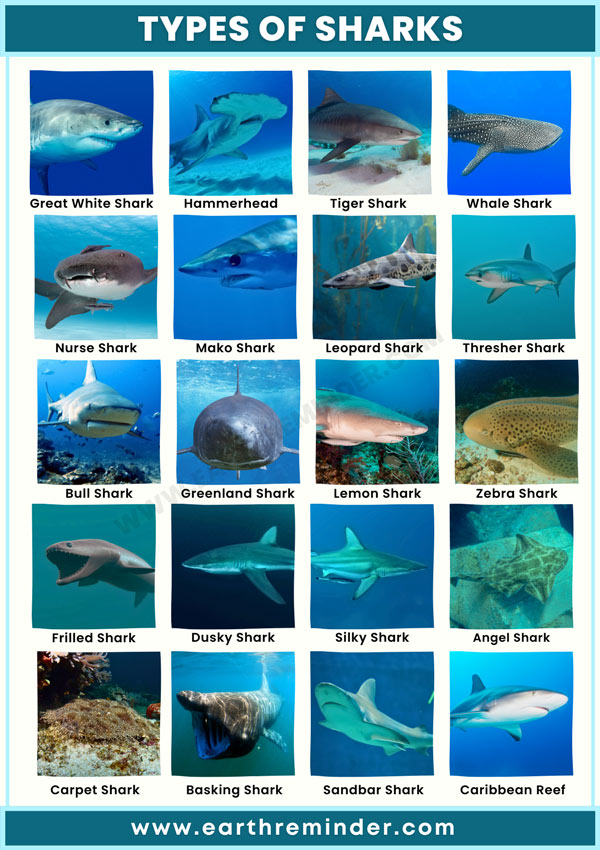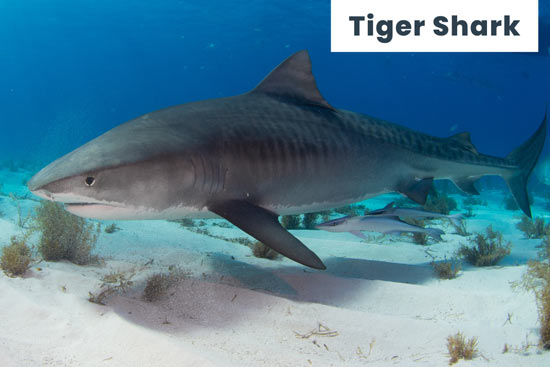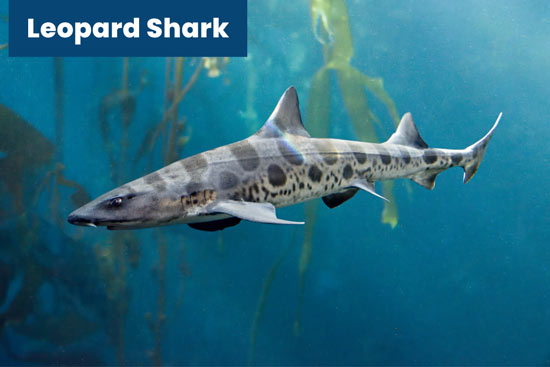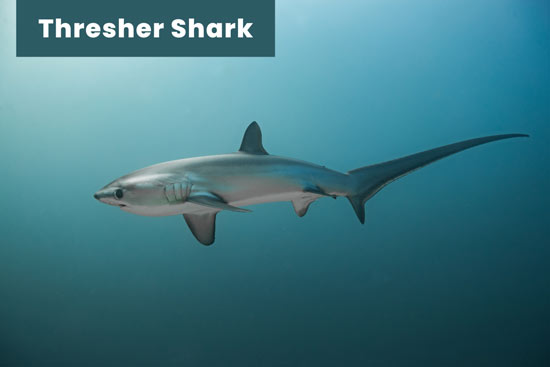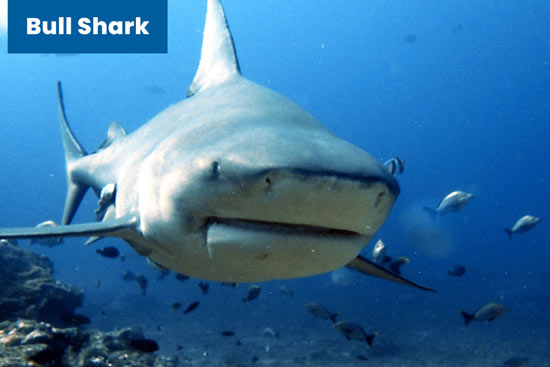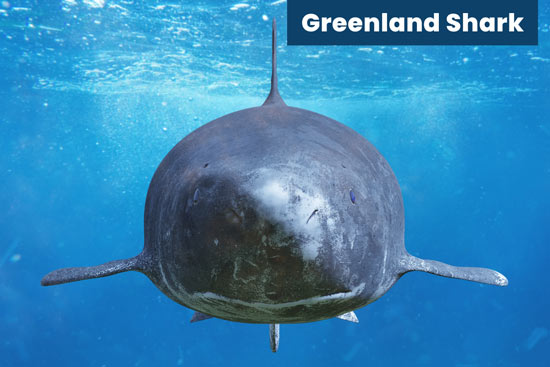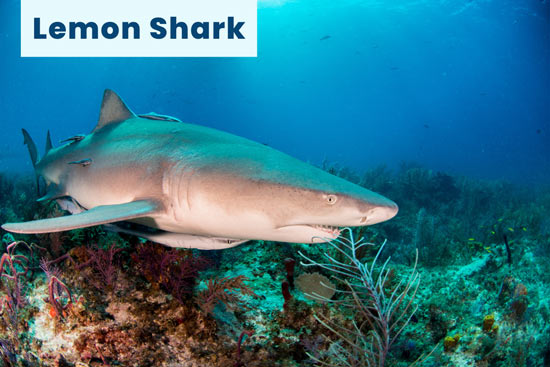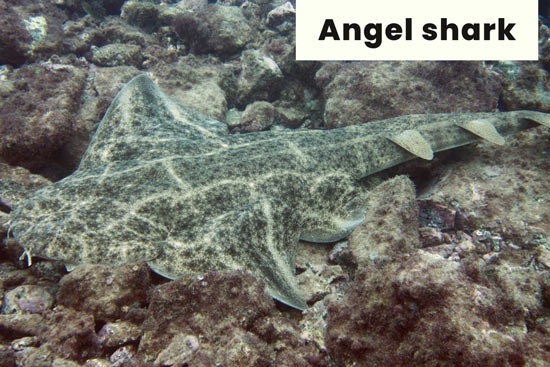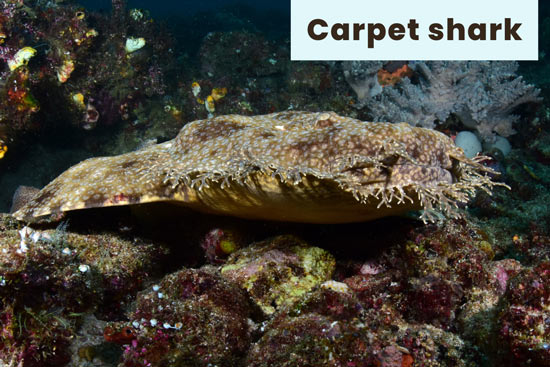Different Types of Sharks | 21 Shark Species With Pictures
Sharks! Just the word alone normally brings up an image of a terrifying predator with razor-sharp teeth waiting in the deep, dark ocean. But in reality, sharks are amazing creatures living in the ocean. There are different types of sharks, which are known for their sleek bodies, strong teeth, and different characteristics, making them powerful water predators. In fact, the number of shark species has surpassed over 500, and they come in a variety of sizes and forms, from tiny species just a few feet long to enormous giants that may reach 40 feet or more. Sharks can be found throughout the world’s oceans, from the shallowest coastal waters to the deepest open ocean. Here, we will learn about the different kinds of sharks and what makes them unique in their own way.
Table of Contents
- 1 Different Types of Sharks
- 1.1 Great White Shark
- 1.2 Hammerhead Shark
- 1.3 Tiger Shark
- 1.4 Whale Shark
- 1.5 Basking Shark
- 1.6 Nurse Shark
- 1.7 Mako Shark
- 1.8 Leopard Shark
- 1.9 Thresher Shark
- 1.10 Zebra Shark
- 1.11 Bull Shark
- 1.12 Greenland Shark
- 1.13 Lemon Shark
- 1.14 Frilled Shark
- 1.15 Dusky Shark
- 1.16 Silky Shark
- 1.17 Angel Shark
- 1.18 Carpet Shark
- 1.19 Sandbar Shark
- 1.20 Caribbean Reef Shark
- 1.21 Smooth-hound Shark
- 2 Conclusion
Different Types of Sharks
Sharks are classified based on physical traits, habitats, and behavioral patterns. The most well-known types of sharks are the great white shark, hammerhead, tiger shark, whale shark, nurse shark, mako shark, leopard shark, thresher shark, bull shark, Greenland shark, lemon shark, zebra shark, frilled shark, Caribbean reef shark, and many more. Let’s discuss them in detail:
Great White Shark
Scientific Name: Carcharodon carcharias
The white shark is without a doubt a shark species that is most widely recognized because of its size, dominance, and stunning look. Great white sharks inhabit the majority of the coastal waters of each significant ocean throughout the world. The only polar regions in the entire globe where great white sharks are not regularly seen belong to the Arctic and Southern Oceans.
These magnificent white sharks can be found around the California coast of the United States, in Japan, South Africa, and Chile, along with various areas throughout the Mediterranean Sea. These sea animals have six highly developed senses—odor, listening, touch, taste, view, and even electromagnetism, allowing them to be particularly well suited to their aquatic surroundings. White sharks consume a wide variety of fish, crustaceans, and marine mammals as part of an opportunistic diet. In addition to bottom fish, young white sharks also eat smaller sharks, rays, and schooling fish, including squids. More giant white sharks gather near seal colonies, where they feast on dead whales.
Hammerhead Shark
Scientific Name: Sphyrnidae
The unusual cephalofoil-shaped head of hammerhead sharks is said to help them with better vision and mobility. In tropical, especially temperate marine seas near the coasts and above the continental shelves, hammerhead sharks are regularly seen. They might move according to the seasons, going poleward throughout the summer and equatorward throughout the winter.
This shark has a strange name because its head has a special shape. This shape helps the shark find its favorite food, which is stingrays. The broad head of the hammerhead shark is used to pin stingrays to the ocean floor in order to catch them. Hammerhead sharks hunt vigorously and even eat small fish, octopuses, squid, as well as crustaceans. Though they are fiercely defensive and just attack whenever provoked, they do not deliberately hunt down humans.
Tiger Shark
Scientific Name: Galeocerdo cuvier
Tiger Sharks are defined by their enormous size, strong jaws, and indiscriminate feeding habits. They get their name from the striking striped patterns on their backs. Tiger sharks are frequently encountered in tropical and warm temperate waters. It resides in marine environments and shallow coastal waters. Because different prey species may congregate there to feed, they seem to prefer muddy coastal areas with fresh water overflow. Due to its varied characteristics, the tiger shark may be easily identified from other requiem sharks. Requiem sharks are a family of sharks to which the tiger shark belongs.
The tiger shark has a wide, flat face and a short nose that is not as wide as its mouth. It also has a long groove near its lips and a slim body. This shark eats almost anything and is always looking for more food. It has been seen to consume a range of marine species, including seabirds.
Whale Shark
Scientific Name: Rhincodon typus
A shark species noticed for its enormous size and gentle temperament is the whale shark. Whale sharks have a broad distribution in tropical and warm-temperate oceans, frequently between latitudes 30°N and 35°S.
One of the popular places to see whale sharks is around the Ningaloo Reef in Australia. But they can also be found in various parts of the world like the Philippines, Mexico, and the Maldives.
All sharks, including whale sharks, have skeletons made of cartilage instead of bone. The whale shark is the largest existing shark species. Whale sharks consume tiny planktonic creatures like krill, jellyfish, and crab larvae. They pull these into their mouth from the water using gill rakers. These are like a net that catches the small food. Then the shark strains out the water and eats the caught food.
Basking Shark
Scientific Name: Cetorhinus maximus
Basking sharks are a calm and filter-feeding species. Basking sharks are the second-largest living sharks, just behind whale sharks. They can grow up to 33 feet long and weigh up to 4.5 tons. They are easy to recognize because of their enormous gaping mouths. Basking sharks use this to filter feed zooplankton, fish, and invertebrates from the water.
The species is found around the coasts and pelagic zones in boreal to warm-temperate oceans. Basking sharks live around the continental shelf and sometimes go in brackish water. They are known to dive deep, reaching depths of at least 910 meters (2,990 feet). A basking shark lives about 50 years. They are currently listed as a vulnerable species, so they need our protection.
Nurse Shark
Scientific Name: Ginglymostoma cirratum
The peaceful behavior of nurse sharks, a type of bottom-dwelling shark, is widely known. Nurse sharks are widespread in tropical and subtropical coastal seas of the Atlantic and Eastern Pacific. They spend the day resting on sand bottoms, caves, and crevices.
As sharks do not have bones, they filter the oxygen in the water using their gills. They belong to a group of cartilaginous fish known as “elasmobranchs”. Elasmobranchs are a well-known fish group that includes all sharks, rays, and skates. They consume small stingrays, sea urchins, bony fish, squid, spiny lobsters, and other crustaceans.
Mako Shark
Scientific Name: Isurus oxyrinchus
A swift and agile type of shark known for its speed and acrobatic leaps is the mako shark. It has a sleek physique, pointed nose, and teeth that are pretty sharp. In tropical and temperate environments, mako sharks are found close to the surface. Although they can also dive deep for prey.
They can go great distances by swimming over entire oceans and being entirely migratory. When hunting, it is recognized for its impressive leaping prowess and has been seen to leap highly high (out of the water). It is well known that shortfin mako sharks migrate widely, with some individuals travelling great distances each year. Fish like herring, mackerel, swordfish, and small cetaceans are among the prey items of mako sharks. They are known for their fierce fighting abilities.
Leopard Shark
Scientific Name: Triakis semifasciata
Leopard sharks are frequently observed in shallow coastal areas and are distinguished by their characteristic spotted look. The leopard shark usually stays close to the bottom and inhabits the shallow bays and estuaries, where it also often patrols the kelp forest.
Mother leopard sharks don’t often release eggs; they hold the eggs within their bodies until they hatch. She gives birth to up to 36 puppies, each measuring around 7 inches long, after 10 to 12 months. Ensuring all eggs hatch is possible by keeping them safe inside her.
Crabs, fish eggs, clam siphons, and other types of burrowing worms are all consumed by leopard sharks. They consume more fish as they get older. Even other sharks and octopuses have been found inside the stomach.
Thresher Shark
Scientific Name: Alopias
Thresher sharks spend much of their time in deep open ocean waters but can sometimes swim into shallow waters or areas close to shore. To stun prey, thresher sharks use their long, whip-like tails.
They have evolved to be endothermic to survive in these cooler waters. Thresher sharks catch prey in a way significantly distinct from other shark species using their caudal fins, which can be as long as their entire bodies. They use their long, scythe-like tail to swat and stun fish before catching them for a meal. Thresher sharks eat small pelagic fish, such as squid, hake, mackerel, anchovies, and sardines. However, the exact species listed may vary as per the location.
Zebra Shark
Scientific Name: Stegostoma fasciatum
The zebra shark is a distinctive, medium-sized shark that inhabits shallow coral reef ecosystems in tropical oceans. To find food, it can maneuver into small holes and caves. Along with the Indian and Red Seas, zebra sharks can be found throughout the western Pacific Ocean across Japan to Australia. Small fish and mollusks are the primary sources of food for zebra sharks.
Young zebra sharks have dark bodies with white stripes. As they age, the pattern transforms into tiny dark specks against a background of greyish brown. As a result, zebra sharks are frequently confused with leopard sharks. The adaptable morphology of this shark enables it to squeeze into tight spaces through reef channels in pursuit of prey. Also, there is a lot of confusion between zebra sharks and leopard sharks because common names are interchangeable everywhere. Thus, it is always better to refer to these sharks by their scientific names to avoid any confusion.
Bull Shark
Scientific Name: Carcharhinus leucas
Bull sharks are well-recognized for their combative nature and are frequently seen in freshwater rivers and coastal locations. They can endure in both freshwater and saltwater habitats.
Bull sharks are white below or undersides and grey on top, which provides camouflage. The bull shark’s high width-to-length ratio gives them a stout appearance, making them appear broader and heavier compared to other requiem sharks of equivalent length.
Bull sharks are not picky eaters. Although the sharks eat fish most often, they can also consume other shark species, marine mammals, birds, and turtles.
Greenland Shark
Scientific Name: Somniosus microcephalus
One of the most notable shark species is the Greenland shark. The only shark species consistently found in the seas north of Iceland is the Greenland shark, the most cold-tolerant in the world.
The longest-living vertebrate across the globe is the Greenland shark. It can live from 250 to over 500 years. Greenland sharks have a varied diet which includes different types of fish such as capelin, char, lumpfish, and salmon. It also eats marine mammals like sea lions, seals, and cetaceans.
Lemon Shark
Scientific Name: Negaprion brevirostris
The Negaprion Brevirostris, often known as the Lemon Shark, is one of the well-studied shark species. The Lemon shark will survive prolonged periods of captivity better than most others. As a result, scientists have had a good opportunity to study their behavior.
The Lemon Shark is a common inshore tropical shark found in Florida’s estuaries and nearby waters along the Gulf and Atlantic coastlines. These sharks consume many bony fish, crabs, mollusks, and small sharks.
Frilled Shark
Scientific Name: Chlamydoselachus anguineus
The frilly look of the gill slits of the frilled shark gives it its name. These sharks are ancient-looking sea animals that inhabit deep, dark waters in various parts of the world including the Atlantic and Pacific Oceans.
Due to their active hunting behavior, frilled sharks have been known to lunge at potential food, swallowing it whole, even if it is rather large. They usually swim in a serpentine, eel-like motion. The frilled sharks have been observed to consume several fish species and other sharks.
Dusky Shark
Scientific Name: Carcharhinus obscurus
The Dusky shark is a fish inhabiting the Atlantic, Mediterranean, as well as Pacific Oceans. It is a dark grey with a brownish color. They typically have darker bellies and are dark grey or brown.
The Dusky Shark possesses long, sickle-shaped pectoral fins. The first dorsal fin is sloping and originates either over or just before the pectoral fin free tips. Between the first and second dorsal fins, there is a pronounced inter-dorsal ridge. The second back fin’s loose end isn’t usually more than two times its own height. These features, along with the dusky tips on the fins, particularly the caudal fin which usually has the darkest margin/tips, are characteristic of the Dusky Shark.
This shark eats larger fish, including tuna, mackerel, flatfish, and eels, and smaller schooling fish like sardines and anchovies. The dusky shark also consumes skates, rays, dogfish, and cat-sharks.
Silky Shark
Scientific Name: Carcharhinus falciformis
The Atlantic, Pacific, and Indian Oceans are home to the common tropical-subtropical epipelagic species, the silky shark. The Silky Shark is recognized for its slim, streamlined body which is gray to almost black on the back, transitioning to off-white on the lower sides, belly, and underside of the snout. Although they lack distinctive markings, their fins have a notable appearance which further distinguishes them among other shark species.
This species eats a variety of bony fish such as tuna and albacore, cephalopods like squid, and, to a lesser extent, crabs as its primary food sources. Within the stomachs of silky sharks, tuna, albacore, squid, and different crustaceans have all been observed.
Angel Shark
Scientific Name: Squatina squatina
A genuinely unusual species of shark is the angel shark. They are frequently mistaken for rays due to their flat bodies and extraordinarily long pectoral and pelvic fins.
Common angel sharks are primarily found in the Mediterranean Sea and the eastern Atlantic, inhabiting both coastal areas and outer continental shelf sediment habitats. Their diet mainly consists of cephalopods, mollusks, and particularly bony fish.
Carpet Shark
Scientific Name: Orectolobiformes
A carpet shark has a unique look and behavior that makes it stand out from other sharks. A carpet shark gets its name from the mottled patterns on its body that resemble complex carpet designs. They have five-gill slits, two spineless dorsal fins, and a small mouth that doesn’t go past the eyes. Some species also have barbels (whiskers-like sensory organs near the mouth), adding further to their unique look.
These sharks live in shallow, coastal waters in tropical and subtropical areas around the world, especially in the Indo-Pacific and Australian oceans. In many instances, they rest on the ocean floor in the warm waters.
Most carpet sharks eat mollusks and crustaceans on the bottom. They hunt on the ocean floor for prey to thrive in their habitats. Reproductive behaviors also differ among carpet sharks, with some laying eggs while others bearing live young.
Sandbar Shark
Scientific Name: Carcharhinus plumbeus
The Sandbar Shark lives in shallow waters like sandy bays and estuaries. Their big first fin on the back and big side fins make them stand out. Usually, they prefer warm waters near the coast, especially along the Florida Gulf and Atlantic coasts.
These sharks are not very big. Male Sandbar Sharks are usually around 6 feet long, while females are a bit longer, up to 8 feet. Their weight ranges from 100 to 200 pounds, but some big ones can reach up to 260 pounds.
Sandbar Sharks take around 12-13 years to grow up and become adults. They can live up to 30 years. Sandbar sharks eat bony fish like croaker and menhaden, along with crustaceans like shrimp and crabs. They also occasionally consume octopuses that live near the ocean floor.
Caribbean Reef Shark
Scientific Name: Carcharhinus perezi
Caribbean reef sharks are among the most popular requiem shark species. They usually measure 6.6 to 8.2 feet (2 to 2.5 meters) in length, but they can get up to 9.8 feet (3 meters). These sharks have heavy bodies and streamlined shapes, which are common in large requiem sharks.
Tropical waters of the western Atlantic and Caribbean, including Florida, the Bahamas, and Brazil, are the most common habitats for this species. They prefer warm shallow waters, usually near coral reefs. They are one of the most common sharks in the Caribbean.
Caribbean reef sharks eat mostly bony fish but also include octopuses and crabs. They also eat squids, crabs, lobsters, shrimps, and various types of reef fish.
This species is viviparous, which means the pups develop inside the mother, just like human babies do. Although Caribbean reef sharks are apex predators in their habitat, they rarely attack humans unless provoked. Caribbean reef sharks play a crucial role in maintaining the ecological balance in their habitat, and their presence signals a healthy marine ecosystem.
Smooth-hound Shark
Scientific Name: Mustelus mustelus
Smooth-hound sharks are slender sharks that have their own characteristics and behaviors. They’re sleek, and silvery, and have slender bodies with short heads and snouts. Their size can reach 159 cm and they weigh more than 13 kg.
Smooth-hound sharks have two dorsal fins without fringes and a caudal fin with a ventral lobe. Their color ranges from grey to greyish-brown, with some specimens having dark spots. Smooth-hound sharks have an infringed dorsal fin and a semi-falcate ventral caudal lobe.
These sharks like sandy, shingle, and light broken ground habitats, and live mostly in shallow waters. They rarely go deeper than 100 meters, and typically come close to shore. Smooth-hound sharks mostly eat small invertebrates and fish from the seabed.
“Sharks fall under the category of fish. Check out the classification of animals in more detail.”
Conclusion
As we have seen above sharks are quite diverse. They’re all different and play their own roles in the ocean. Understanding them goes beyond science; it’s about getting a deeper understanding of the underwater world. They are living reminders of the ocean’s complexity and beauty. Sharks are more than just ocean predators; they’re essential to a healthy ocean. They teach us there’s still so much to discover, and that all lives matter. We need to protect and conserve the different species of sharks so the next generation can enjoy and learn from them.

